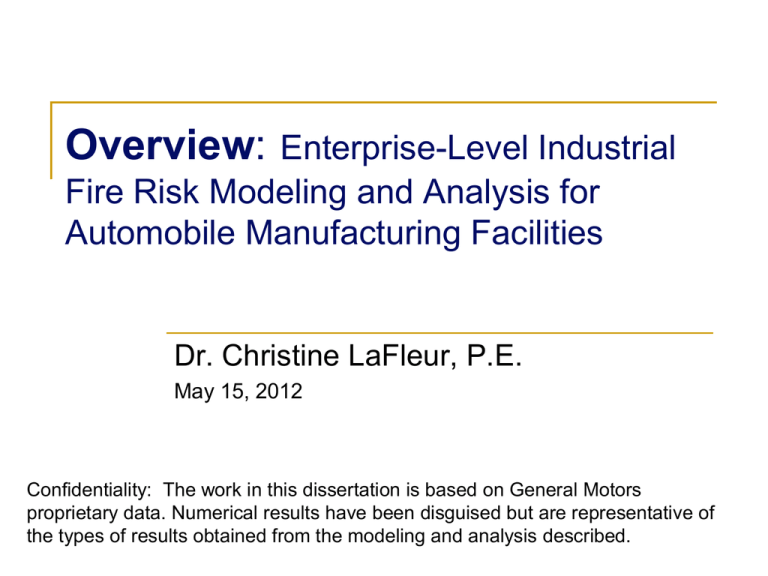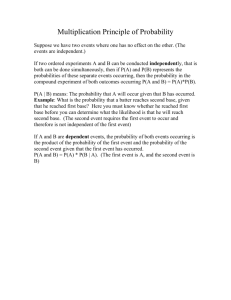Overview: Enterprise-Level Industrial Fire Risk Modeling and
advertisement

Overview: Enterprise-Level Industrial Fire Risk Modeling and Analysis for Automobile Manufacturing Facilities Dr. Christine LaFleur, P.E. May 15, 2012 Confidentiality: The work in this dissertation is based on General Motors proprietary data. Numerical results have been disguised but are representative of the types of results obtained from the modeling and analysis described. Agenda Problem Statement Summary of Methods Summary of Results/Outputs Problem Statement Business leaders need to be able to identify, quantify and analyze the risks posed to their enterprise by fire. Enterprise risk models and analysis tools are needed to support strategic decisions but do not currently exist. 3 Background on the GM Enterprise General Motors: 158 manufacturing sites Located in 30 countries 202,000 employees Produces 7.5 million vehicles per year Sold in 120 countries 4 Overview of Auto Manufacturing Process and Associated Fire Hazards Engine & Transmission Plant Casting Shop Molten metals Furnaces Stamping Machining, Grinding Mist Collection Heat Treatment Body Shop Oily Scrap Metal Robotic Welding Powertrains and other components Paint Shop Assembly Solvents Electrostatic Spraying Fluid Fill Suppliers Dealers Seats, Wheels, Wiring Carpet, Headlamps, etc. 5 Summary of Methods Developed a multi-dimensional systems modeling framework for aggregating/disaggregating fire frequency and severity Designed and implemented an enterprise fire risk database Developed and deployed a global procedure for fire data collection Built tools to visually analyze and compare fire risk across portfolio of manufacturing processes and plants Demonstrated utility of results in a specific case study analyzing costs and benefits of fire protection options in paint shop operation. 6 Key to the Analysis Data – Need accurate, complete data on fire events from the automotive industry Global loss reporting database developed to comply with SarbanesOxley Act of 2002 GRIT – Global Reporting & Investigations Tool Database Architecture: 7 Process-Based Analysis of Frequency Determined that a Poisson distribution is the preferred model fit based on : Theoretical property of aggregation/ disaggregation Easy to measure mean number of fires per year (intensity parameter λ) Fire hazards are inherent to the process where fire originates Processes within automobile manufacturing are homogeneous across plants, countries and regions. This allows frequency model to be applicable to plants that did not contribute to the data. All fire origin areas in GRIT were mapped to 14 discrete process groupings Process fire frequencies were then calculated using modified Poisson model 8 Process Groupings ProcessCode AS CA CO DC HZ Process Name Assembly Casting/Foundry Computer Room Dust/Mist Collector Laboratory/Dyno/Test Cells Heat Treat Hazardous Material/Storage MG PA RW SP ST SU TR Machining and Grinding Painting & Ovens Robotic Welding Stamping/Press Storage Support Area Trash DY HT Fire Frequency (Chance of Fire per Day) 0.0038 0.0104 0.0001 0.0009 0.0018 0.0022 0.0001 0.0056 0.0011 0.0088 0.0029 0.0011 0.0059 0.0011 9 Process Groupings ProcessCode AS CA CO DC HZ Process Name Assembly Casting/Foundry Computer Room Dust/Mist Collector Laboratory/Dyno/Test Cells Heat Treat Hazardous Material/Storage MG PA RW SP ST SU TR Machining and Grinding Painting & Ovens Robotic Welding Stamping/Press Storage Support Area Trash DY HT Fire Frequency (Chance of Fire per Day) 0.0038 0.0104 0.0001 0.0009 0.0018 0.0022 0.0001 0.0056 0.0011 0.0088 0.0029 0.0011 0.0059 0.0011 Poisson approximation: Probability of one or more fires per day is roughly equal to the Poisson intensity l*1 day (t) = l 10 Mapping of Process Grouping to Plant Each process contributes distinct fire hazards and independent fire arrival rate l Easy to map processes at each plant Site fire rate = Σ (process rates at plant) Process Code AS CA CO DC DY HT HZ MG PA RW SP ST SU TR Plant 1 Defiance x x x x x x x Plant 2 Bay City Plant SMCO3 x x x x x x x x x x x x x x x x x x x x x 11 S Process-Based Fire Frequency by Plant Site Name Plant B Plant Y Plant S Plant F Plant T Plant C Plant W Plant N Plant G Plant K Plant R Plant Z Plant O Plant T Plant A Site B Facility B Plant E Site E Plant L Site Z Site A Site D Aggregated Lambda Average Number of Fires Per Day 0.046 0.046 0.046 0.044 0.043 0.039 0.035 0.035 0.035 0.035 0.035 0.034 0.033 0.033 0.033 0.032 0.032 0.031 0.031 0.031 0.031 0.030 0.030 Note: The data has been disguised for confidentiality purposes, but is representative of results. 12 Severity Modeling Process-Based Calculated from fire events – GRIT data Are used to quantify loss from fires involving a given process Are used to prioritize fire protection criteria at the process level Plant-Based Represents the potential of a fire in a given facility to become a significant fire Are used to estimate the potential size of the impact from a significant fire 13 Process-Based Severity Assessment $25,000 No processes in the high frequency/high severity quadrant DY $20,000 Severity (Loss/Fire) Process Grouping AS CA CO DC DY HT HZ MG PA RW SP ST SU TR Average Estimated Value/Loss (USD) $ 2,200 $ 5,000 $ 1,200 $ 1,100 $ 20,500 $ 700 $ 400 $ 3,000 $ 1,600 $ 1,000 $ 200 $ 8,500 $ 3,500 $ 200 $15,000 $10,000 ST CA $5,000 PA CO HZ $0 0.0000 DC TR AS SU MG RW HT SP 0.0020 0.0040 0.0060 0.0080 0.0100 0.0120 Probability (Fire Frequency) Property damage only Note: The data has been disguised for confidentiality purposes, but is representative of results. 14 Plant-Based Severity Assessment Fire Risk Index (FRI) developed as a relative risk ranking to characterize the potential to be a severe fire. Business Interruption Value (BIV) used to quantify the potential exposure of a severe fire Quantifies the severity in terms of dollars Provides estimate of value of lost production 15 Fire Risk Index (FRI) Qualitative approach used because quantifying the potential for a fire to develop into a significant fire is extremely complex and involves detailed analysis of plant occupancy, configuration, and potential fire size Such data is not available for an entire enterprise and is not feasible to collect Absolute value of risk is not necessary for decision makers, only used as a comparison therefore relative risk ranking is appropriate Six hazard categories identified relative to severity: Exposure, Construction, Supervision, Automatic Sprinklers, Water Supply, Special Hazards 16 FRI Results Plant Plant 1 Plant 2 Plant 3 Plant 4 Plant 5 Exposure 0 0 0 10 0 Construction Supervision Sprinklers 9 0 1 15 0 15 9 0 20 12 0 75 12 0 5 Water Supply 0 0 0 50 0 Special Hazards 3 60 0 68 0 FRI 13 90 29 215 17 Fire Risk Index (Severity) 300 250 Plants with severity exposure (FRI) significantly higher than the majority of the enterprise. 200 150 100 50 0 0 20 40 60 80 100 120 140 Individual Plants Note: The data has been disguised for confidentiality purposes, but is representative of results. 17 Business Interruption Value (BIV) Assembly Plant BIV Source Plant BIV BIV BIV ( A) Net Pr ofit Pr oductionVehicles NumberofDaysDown Vehicle Day PercentDependancy(i) BIV (i) iDependentPlants Engine Plant 1 Component Plant 1 Engine Plant 2 Transmission Plant 1 Component Plant 2 Assembly Plant X Assembly Plant Y Transmission Plant 2 Value for number of days down was 90 days based on manufacturing forecast data and industry convention. 18 Summary of Results: Decision Support Tools System Model outputs will include (Tools 1 - 8) Risk profiles and risk maps to identify processes or plants with greatest risk factors Quantification of fire risk to track progress of risk reduction initiatives over time Fire protection trade-off analysis (Tool 9) Developed process-level event tree tool Constructed event trees for individual fire protection criteria decisions Allowed different fire protection criteria to be compared based on their impact on risk level. Can be analyzed by process, plant, or overall enterprise impact. 19 Tool 1: Global Fire Risk Profile 300 Fire Risk Index (Severity) 250 Highest Risk Quadrant 200 150 100 50 0 0 0.01 0.02 0.03 0.04 0.05 Fire Frequency (Percent Chance Per Day of a Fire Occurring) 20 Tool 2: Fire Risk Profile by Division 300 Fire Risk Index (Severity) 250 CANADA GMPT GMVM MFD SPO GMAP GMDAT GMdB GME GMLAAM HOLDEN SGM Plants showing same frequency due to similar proceses/functions but site-specific variation in potential severity 200 150 100 50 0 0 0.005 0.01 0.015 0.02 0.025 0.03 0.035 0.04 0.045 0.05 Fire Frequency (Percent Chance Per Day of a Fire Occurring) 21 Tool 3: Risk-Based Fire Protection Spending Prioritization 300 Fire Risk Index (Severity) 250 Highest priority for fire protection spending Fire protection spending targeting key risks 200 150 Lowest priority for fire protection spending 100 50 0 0 0.01 0.02 0.03 0.04 0.05 Fire Frequency (Percent Chance Per Day of a Fire Occurring) 22 Tool 4: Regional Risk Prioritization Models 160 140 140 Fire Risk Index (Severity) Fire Risk Index (Severity) North America 160 120 100 80 60 40 20 0 0.005 Europe 120 100 80 60 40 20 0.01 0.015 0.02 0.025 0.03 0.035 0.04 0.045 0 0.005 0.05 Fire Frequency (Percent Chance Per Day of a Fire Occurring) 0.02 0.025 0.03 0.035 0.04 0.045 0.05 Latin America, Africa, Middle East Asia Pacific 160 300 140 Fire Risk Index (Severity) Fire Risk Index (Severity) 0.015 Fire Frequency (Percent Chance Per Day of a Fire Occurring) 350 250 200 150 100 50 120 100 80 60 40 20 0 0.005 0.01 0 0.01 0.015 0.02 0.025 0.03 0.035 0.04 Fire Frequency (Percent Chance Per Day of a Fire Occurring) 0.045 0.05 0 0.01 0.02 0.03 0.04 0.05 Fire Frequency (Percent Chance Per Day of a Fire Occurring) 23 Tool 5: Facility Acquisition Risk Evaluation 260 240 Site Being Evaluated for Acquisition Fire Risk Index (Severity) 220 200 180 160 140 120 100 80 60 40 20 0 0.005 0.01 0.015 0.02 0.025 0.03 0.035 0.04 0.045 0.05 Fire Frequency (Percent Chance Per Day of a Fire Occurring) 24 Tool 6: Process Level Fire Risk Characterization Trash Assembly Support Area Storage Casting/Foundry Stamping/Press Computer Room Robotic Welding Dust/Mist Collector Laboratory/Dyno/Test Cells Highest Fire Frequency Heat Treat Highest Fire Load Painting & Ovens Hazardous Material/Storage Machining and Grinding 25 Tool 7: Process Level Ignition Source Analysis Count of Total Ignition Grouping Fires Percent AS 0 - Liquid Fueled Equipment 102 4% 4 1 - Solid Fueled Equipment 15 1% 1 2 - Electrical Equipment 344 13% 47 3 - Hot Objects 364 14% 20 4 - Open Flames and Smoking 408 16% 57 5 - Natural Sources 25 1% 2 6 - Hot Work Operations 736 29% 41 7 - Other or Unknown 556 22% 40 Total 2550 212 AS % CA 2% 7 0% 0 22% 6 9% 58 27% 1 1% 2 19% 10 19% 14 98 CA % PA PA % RW RW % 7% 3 5% 3 1% 0% 0 0% 3 1% 6% 22 39% 36 7% 59% 7 13% 21 4% 1% 1 2% 25 5% 2% 0 0% 8 2% 10% 10 18% 397 75% 14% 13 23% 33 6% 56 526 ST 2 2 27 10 34 2 25 65 167 ST % SU SU % 1% 24 3% 1% 6 1% 16% 140 17% 6% 107 13% 20% 163 19% 1% 8 1% 15% 157 19% 39% 234 28% 839 Action items can be identified based on trends: Electrical equipment fires in key areas Improper disposal of smoking materials Hot work fires show need for better housekeeping and control of permit process 26 Tool 8: Process Level Materials Involved Analysis Material Grouping Count of Total Fires Percent AS AS % CA CA % PA PA % RW RW % ST ST % SU SU % 0 - Industrial and Production Vehicles 1 - Cooking Equipment 226 35 9% 1% 59 1 28% 0% 3 0 3% 0% 24 0 5% 0% 7 0 13% 0% 42 0 25% 0% 73 33 9% 4% 2 - Electrical Distribution Equipment 3 - Office Equipment 4 - Manufacturing Equipment 5 - Heat Transfer/Air Circulating Equipment 6 - Production Materials (Liquids/gases) 7 - Production Materials (Solids) 8 - Residue/Overspray Build-up 9 - Other/Misc incl. Trash 225 20 307 9% 1% 12% 21 2 12 10% 1% 6% 3 0 34 3% 0% 35% 37 1 35 7% 0% 7% 5 0 13 9% 0% 23% 14 0 2 8% 0% 1% 106 12 43 13% 1% 5% 74 3% 8 4% 3 3% 7 1% 4 7% 1 1% 40 5% 55 417 209 919 2550 2% 16% 8% 36% 2 28 10 66 209 1% 13% 5% 32% 5 17 6 27 98 5% 17% 6% 28% 9 2% 190 36% 30 6% 193 37% 526 6 6 5 10 56 11% 11% 9% 18% 2 1% 16 21 13% 107 5 3% 45 80 48% 334 167 809 2% 13% 6% 41% Action items can be identified to address: Trash fires in all key areas Production and production-support vehicle fires Manufacturing equipment fires will impact production capability 27 Tool 9: Fire Protection Criteria Analysis Case Study Provide a decision support tool for analyzing tradeoffs in fire protection investment and prioritizing risk reduction strategies. Provide cost benefit analysis for business case support. Develop and justify alternative fire protection criteria in emerging, low cost markets with minimal legal fire code requirements. Provide a reliable, consistent, engineering-based, and defendable risk quantification framework for fire protection criteria 28 Overview of Event Tree Construction Successive layers of fire protection Emergency interlocks Start here Process protection Branch line probabilities Calculated by multiplying each probability in the branch …. Detection system success 0.98 Chance of failure Chance of having a fire 0.0011 Calculated from fire incident reporting database Time Chance of success Detection system failure 0.02 a. Chance of specific branch event occurring Chance of success b. Chance of specific Chance of failure c. Chance of specific Chance of success Chance of failure branch event occurring branch event occurring d. Chance of specific Chance of success Chance of failure branch event occurring e. Chance of specific branch event occurring f. Chance of specific branch event occurring 29 Total Annual Risk Value Branch Line Probabilities a. Chance of branch event occurring b. Chance of branch event occurring event occurring f. Chance of branch event occurring f. Extreme PD and BI due to total loss of building. f. PD Value f. Downtime a. BI value = days down multiplied by daily contribution margin a. Expected Value Calculation: (PD+BI)* (a. branch line probability) ...... e. Chance of branch a. Estimate of days downtime Risk Value ...... event occurring a. Estimate of Property Damage ...... d. Chance of branch property damage. Slight BI due to system check and restart. ...... event occurring a. Minimal/no Severity Calculation ...... c. Chance of branch Description of Scenario Outcome f. BI value Total Event Tree Annual Risk Value: f. Expected value Sum of a to f Expected value 30 Cost Benefit Analysis Event Tree A Event Tree B Scenario Paint Booth Fire WITH sprinklers at Roof level Paint Booth Fire WITHOUTsprinkler s at Roof level Expected Life of Total Annual Equipment Risk Value (years) $ Life Cycle Risk Cost 843,779 20 $ 16,875,589 $ 2,452,485 20 $ 49,049,701 Life Cycle Cost Difference $ 32,174,113 Initial Capital Cost of Roof-Level Sprinklers $ 6,000,000 Decision: GO or NO GO GO Ignores time value of money Assumes expected useful life of paint shop is 20 years Note: The data has been disguised for confidentiality purposes, but is representative of results. 31 Questions? 32






